Mechanical Micro Drilling Advances
Published: 01 May 2009
by Pietro Zulli
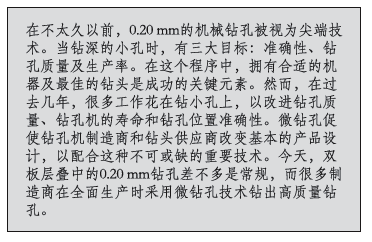
The architecture of drilling machines and bits has improved significantly over the past few years, facilitating increased small drilled hole productivity.
In the not so distant past, 0.20 mm mechanically drilled holes were considered state-of-the-art. In the past few years, however, a great deal of effort has been devoted to small hole drilling to improve the drill hole quality, drill life and hole location accuracy. Micro drilling has prompted machine manufacturers and drill bit suppliers to change basic product designs to accommodate this important and indispensable technology. Today, drilling 0.20 mm in a two-panel stack is almost a routine occurrence, and many manufacturers make high-quality holes using micro drilling techniques in full production.When drilling small, deep holes, there are three main goals: accuracy, hole quality and productivity. In this process, having the right machine and an optimum drill bit for the challenge are critical components for success.
The drill bit is perhaps the most important factor in any drilling process. Even if all the other segments of the drilling operation are perfect, the outcome would be less than optimum if a damaged or improper drill bit is used. Drill bits are designed with three basic needs in mind. The bit needs to be rigid to address the critical aspect of registration through the hole and to ensure straight holes, from top to bottom through the stack. It also needs strength to withstand the forces generated during drilling and finally, it must be maintained to provide a sharp cutting edge over the life of the tool.
The main area of work in drill bit geometry is mostly centered on web thickness (FIGURE 1). By reducing a bit’s web thickness, a number of positive elements are created. More chips can be removed during drilling, preventing the bit from snagging. It reduces the drill bit’s “crush” zone, the area of the bit working more like a punch than a cutter. A larger web also requires more force to be exerted on the bit for drilling.
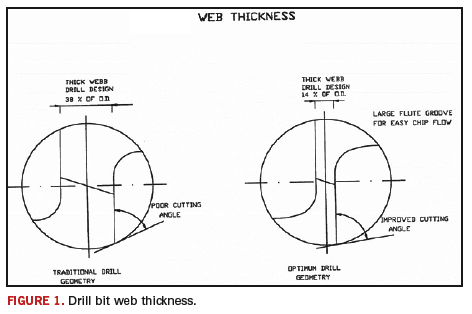
Choosing the proper flute length for a job is as important as choosing the correct feed and speed.
If a tool with a flute which is too long is used, the risks include: unnecessary drill breakage due to the reduced strength of an extended flute drill; accuracy problems due to the drill bit’s tendency to wander more because of the added length; and reduced productivity due to reduced feed rates to compensate for the first two problems.
If a tool with a flute which is too short is used, the risks include: incomplete drilling due to the bit being too short; and poor hole wall quality due to the bit overheating and its inability to remove chips from the hole.
Drill breakage can also be caused by the bit snagging on the chips that haven’t been removed. The overall flute length should be the thickness of the material to be drilled plus 20% for chip clearance at the top of the stack (FIGURE 2).
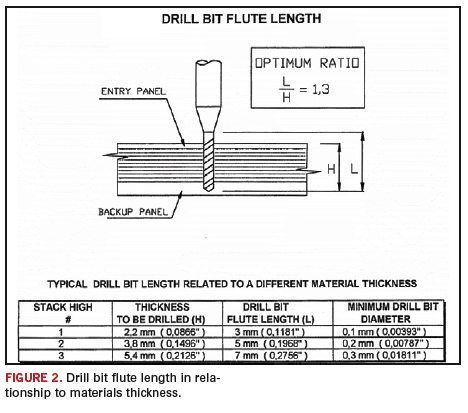
Entry and backer material plays an important role in micro drilling. The entry materials must provide flatness and a smooth surface for the drill bit to make contact with, allowing the bit to enter the board stack as straight as possible. The material should be hard, in order to prevent entry burrs, which can be pushed back into the hole creating subsequent problems later on in the process. It also needs to have a consistent thickness and composition to ensure consistency in hole wall quality.
The entry and backer material should not increase drill wear, as this can impact hole wall quality, as well as the number of holes a drill bit can produce. In addition, reducing the number of hits before resharpening or changing tools increases costs. The entry and backer materials should minimize drill temperature to reduce smearing and drill bit wear, and the materials selected should be designed to not deposit back into the hole.
There are a number of different backup and entry materials available. According to the particular requirements of the job to be executed, the manufacturer has to choose which is the best, taking into account the characteristics of the material as mentioned.
Pits and dents in the panel surfaces can also be problematic, surface imperfections can deflect a small diameter drill bit. Newer drilling machines offer many options in stacking, registration and autoloading, but in all cases, stacks must be clean, free of burrs and have no spaces between the panels.
Most problems associated with the drill bit can be attributed to poor handling techniques. People handle bits many times before drilling. Providing the maximum protection for small bits is certainly a matter of considerable importance for the user, this is especially true in the light of the extreme fragility of many small drill bits which can be broken by a careless touch. The reject rate due to routine handling is quite high.
A great deal of effort has been devoted to new packaging methods that eliminate handling of small bits. Cooperation between some drilling machine constructors and drill bit suppliers has resulted in a revised packaging design, consisting of a plastic strip which contains 10 tools and is designed to be directly inserted into the drilling machine’s tool changer magazine, eliminating handling.
In order to achieve proper feed and table speed, many variables have to be taken into account, that’s why the tool parameters are never perfect. Every drill room has a different opinion when it comes to the importance of bit life, hole quality, drill wander and hit rate.
Optimum feed and speeds for small hole production greatly depend on the drilling machine’s performance and drill bit design. Based on the experience of experts and on the results of many tests, some parameters are well known. Tool life and hole quality, for example, are mostly subordinated to the drill bit peripherical speed in surface feet per minute (SFM), as shown in FIGURE 3.
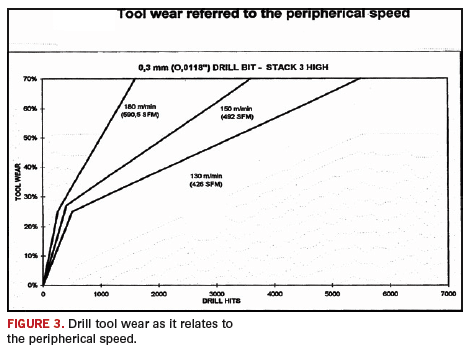
Many changes have been made to drilling equipment in the last few years. The principal areas where attention has been directed are:
- Spindle speed
- Spindle collet run-out
- Pressure foot
- Axes positioning and stability
Since abandoning ball bearing spindles, where the maximum speed was 80,000 RPM, the performance
of air-bearing spindles has greatly helped the micro drilling process, and today, spindles running at more than 250,000 RPM are available.
From a machine standpoint, run out is the greatest contributor to drill breakage and accuracy problems. A big help in the drastic reduction of spindle run out has been the elimination of collars on the drill bit. This solution offers various benefits from a technical (FIGURE 4) and economic point of view.
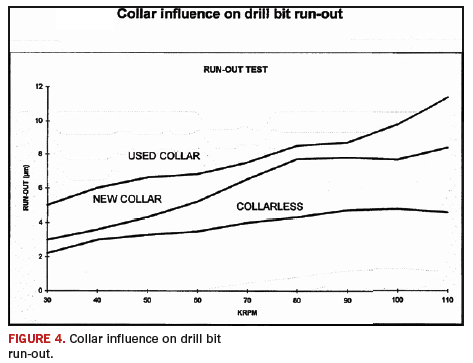
Since spindles behave differently at different speeds, it is very important to see what is happening when the actual drilling speed is achieved. A solution has been found in an accurate laser station which, when directly installed on drilling machines, is able to perform in real time, checking tool height, diameter and dynamic run-out in a few seconds.
The elimination of the collar has facilitated the reduction of the pressure foot insert (FIGURE 5). In fact, with large hole pressure foot inserts, there is a tendency for thin panels to lift during the drilling cycle (“oil can effect “), but with small inserts, the pressure foot force acts on a very limited area around the hole to be drilled, thus avoiding the oil canning. In addition, a better vacuum concentration is created for a fast and improved chip evacuation, critical for small hole drilling.
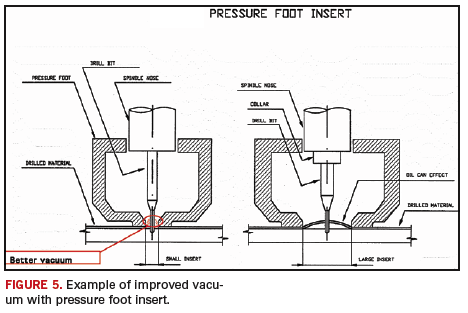
A smooth, accurate axis positioning system is an important aspect of any drilling machine. An axis with overshoot or with positioning difficulty will lead to accuracy problems, as well as reduced productivity. By applying new technical solutions and with the reduction of the mass in motion, high speed and acceleration can be achieved.
In order to reach fast and accurate axis positioning, the addition of linear motors on XY axis and the change to low mass on axis has been found beneficial. These improvements have increased small hole drilling productivity and quality possible.
Much of the work has now been done to improve the architecture of drilling machines, making a significant increment of small hole productivity possible. Eventual problems have to be faced starting with the process engineering approach; quality, productivity and process control are aspects that cannot be treated independently. PCD&F
Pietro Zulli is an applications engineers with Pluritec Industries; This email address is being protected from spambots. You need JavaScript enabled to view it..




